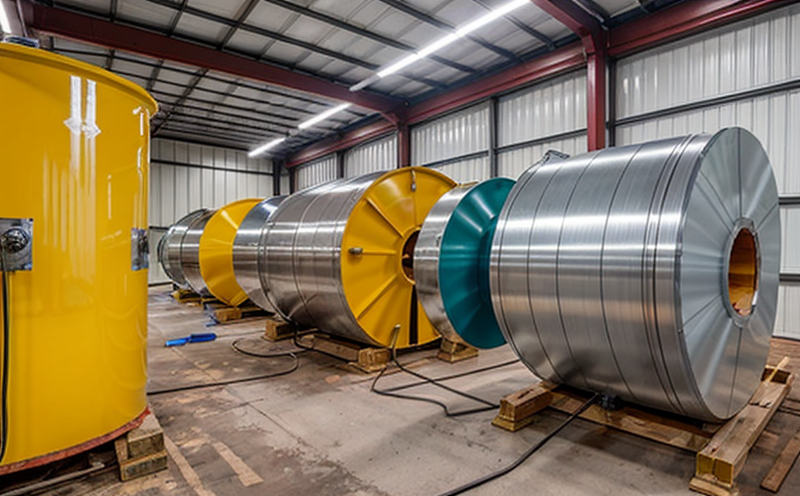ASTM D1308 Chemical Spot Resistance Testing of Paints
The ASTM D1308 test method is designed to evaluate the chemical resistance of paints and coatings used in marine environments. This standard specifies a procedure for determining the resistance of paint films to the action of concentrated acids, alkalis, salts, solvents, or other corrosive chemicals. The primary purpose of this testing is to ensure that the coatings applied to ship equipment can withstand exposure to harsh chemical environments without degradation.
In marine applications, such as those found in the hulls of ships and offshore structures, the environment is often highly corrosive due to saltwater immersion, presence of biofouling organisms, and frequent contact with various chemicals used for maintenance or cleaning. ASTM D1308 helps manufacturers and quality assurance teams ensure that paints selected for these applications will perform reliably under real-world conditions.
The test involves exposing a specimen painted according to the standard procedure to one or more aggressive chemical solutions (such as hydrochloric acid, sodium hydroxide, or acetone) and then assessing the extent of any damage. The results are reported in terms of spot size, which indicates how much paint has been damaged by the contact with the chemical.
For accurate testing, specimens must be prepared following strict guidelines provided in ASTM D1308. This typically includes applying a specific type and thickness of paint to a defined area on a substrate material like steel or aluminum. After painting, the specimen is allowed to cure before undergoing the chemical exposure test. Proper sample preparation ensures that any observed damage can be attributed to the chemical resistance properties of the paint rather than other factors.
The equipment used in this testing includes containers for holding the chemicals, spray nozzles or immersion chambers for applying the chemicals to the painted area, and measurement tools such as rulers or micrometers for quantifying the extent of damage. The test results are crucial not only for product development but also for regulatory compliance with international standards like ISO 12944.
ASTM D1308 is particularly important in industries where marine equipment plays a critical role, such as naval defense, commercial shipping, and offshore oil and gas operations. By ensuring that coatings meet this standard, manufacturers can enhance the durability and lifespan of their products while reducing maintenance costs associated with premature failure due to chemical exposure.
Compliance with ASTM D1308 is essential for companies operating in these sectors as it helps protect against potential liability issues related to product failures. Additionally, meeting such standards enhances a company’s reputation among customers who prioritize quality and reliability in their procurement decisions.
In summary, the ASTM D1308 test provides a robust framework for evaluating chemical resistance properties of paints used in marine applications. Its rigorous procedures and objective measurements make it an indispensable tool for researchers, engineers, and quality assurance professionals working within this sector.
Benefits
Conducting ASTM D1308 Chemical Spot Resistance Testing of Paints offers several key advantages:
Ensures compliance with international standards, enhancing product reliability and safety.
Facilitates consistent quality control processes across manufacturing batches, reducing variability in performance.
Supports innovation by providing data on how different formulations perform under challenging conditions, guiding future R&D efforts.
Improves customer satisfaction through the provision of durable, high-performance coatings that meet or exceed expectations.
By incorporating ASTM D1308 into their quality assurance protocols, organizations can demonstrate commitment to excellence and build trust with stakeholders. This testing also aids in regulatory compliance, which is crucial for maintaining market access and avoiding costly penalties.
Eurolab Advantages
Eurolab, a leading laboratory specializing in marine & ship equipment testing, offers unparalleled expertise when it comes to ASTM D1308 Chemical Spot Resistance Testing of Paints. Here’s why working with Eurolab is advantageous:
State-of-the-art facilities equipped with precision instruments that ensure accurate and reliable test results.
A team of experienced technicians who understand the nuances of marine coatings testing, providing insights tailored to your specific needs.
Comprehensive services spanning from initial consultation through final report generation, ensuring a seamless process for clients.
Access to cutting-edge research and development resources that can help push boundaries in coating technology.
Our commitment to excellence extends beyond just meeting standards; we aim to exceed expectations by offering personalized service and technical support throughout every phase of your project. Whether you're looking to validate existing formulations or develop new products, Eurolab is here to assist you at each step along the way.
Use Cases and Application Examples
The application of ASTM D1308 Chemical Spot Resistance Testing extends across various sectors including naval defense, commercial shipping, offshore oil & gas exploration, and recreational boating. Below are some specific use cases:
| Use Case | Description |
|---|---|
| Hull Maintenance | Determine the effectiveness of paints used on ship hulls against saltwater corrosion and other aggressive chemicals. |
| Offshore Platforms | Evaluate coatings for platforms exposed to harsh marine environments, including exposure to oil spills or cleaning agents. |
| Naval Vessels | Assess protective paints on naval vessels subjected to various chemicals during maintenance and operation. |
| Recreational Boats | Ensure that hull coatings used in recreational boats are resistant to common cleaning agents and environmental factors. |
In addition to these examples, ASTM D1308 testing can be applied wherever there is a need for durable paint protection against chemical exposure. The results from this test provide valuable information that helps manufacturers improve their products continuously, ensuring they remain competitive in an ever-evolving market.
For instance, naval architects may use the findings to optimize protective coatings for submarine exteriors, while oil companies could apply similar insights towards protecting pipelines from chemical degradation.
The data generated can also inform decisions regarding maintenance schedules and replacement intervals, ultimately leading to cost savings and increased operational efficiency.





